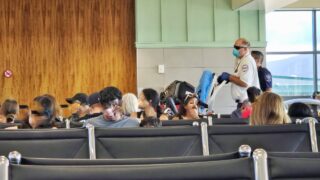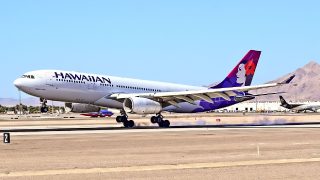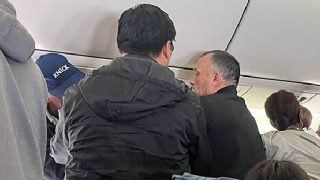Have you ever wondered what would happen in a medical emergency hours away from the nearest land, such as en route to Hawaii? The longer the flight, the more likely such an incident is to occur.
Here’s what I witnessed on a recent flight from Papeete to Honolulu.


Medical monitoring in the air: what to expect.
A small medical kit is brought to the passenger. This allows someone without medical experience to collect vital signs and transmit them to ground-based medical experts. Real-time data typically tracked, much like in an Emergency Room, includes electrocardiogram, temperature, blood pressure, blood oxygen and respiration.
Delta, Continental, Hawaiian and most other carriers (80 airlines total) are now using some form of these.
Remote emergency medical responders on the ground.
Expert medical advice from board-certified emergency physicians and specialists is now available at all times by phone (via satellite when over the ocean). Continental says it makes about 135 such calls per month, resulting in, on average, 6 flight diversions per month.
Will your flight be turning back?
Nothing is fixed in stone, and the final authority rests with the captain. Typically however, flying over the ocean, if you are over half way to your destination, no matter the nature of the incident, your flight will continue. If you are less than half-way, you’ll likely be turning around. In our case, we were just over half way, so the flight continued on to Honolulu, where we were met by waiting medical personnel.
Preventive measures: Newark to Honolulu passenger deplaned.
As Continental’s non-stop was preparing for takeoff recently, a 16 year old girl started coughing violently and had trouble breathing due to a cold. As a precaution, Continental returned to the gate and removed the passenger. The airline paid for her stay in New York and flew her to Honolulu when she felt better. That decision resulted in far less cost than should a diversion have been deemed necessary.
Why this technology is so beneficial.
1. Of greatest importance (at least to us passengers), this dramatically improves the quality of emergency medical care on board.
2. Airlines save money by not needing to divert unnecessarily, thus saving millions in extra costs per year. As in the example above, airlines call MedAire prior to departure when a concern arises. That often serves to prevent mid-air emergencies before they happen.
3. Airlines improve their customer relations by delivering protection that meets or exceeds expectations and reflects health and safety values.
Have you had any experience with mid-air medical emergencies that you can share?






I am a physician who recently helped during a medical emergency over the Pacific. The flight crew was well trained, the medical kit was well organized and stocked with medicines and equiptment (including IV fluids and medicines) and overall I was suprised how well everything went.
I also was on a flight over the Pacific when a passenger became very agitated and psychotic. Again, the flight crew handled this exceptionally well, and with the help of the passenger’s travelling companion and some of the medicines that the passenger had on board, a significant crisis was averted.
It’s important for our Hawaii travelers to know this information about what happens in a case of medical emergency when flying to the islands. Medical equipment on planes has improved quite a bit and flight attendants are trained for emergencies. However, most of us has experienced the situation when the pilot or purser was asking for a medical doctor on board.
We all have to show responsibility when starting a flight in bad physical health. Better to be save than sorry and postpone the flight to Hawaii. You wouldn’t enjoy your vacation anyways.
Aloha Pua
Best Hawaii Vacation Blog
I like this article so much, I’ve added it to the Travel Mamas website on our News page! http://www.travelmamas.com/Pages/travel-mama-news.html#AirTravel
This is in regard to your article regarding a medical emergency in the air. There are some corrections that need to be made regarding the above article. There are many reasons that determine what a flight does and where it diverts to during a medical emergency. Also, all of these reasons a passenger does not need to know. Flight crews are trained to deal with a medical emergency. With hopefully the aid of a medical professional, who maybe traveling on board can assist the passenger until either on the ground or until the flight has reached their final destination. Of course, the health and well being of a passenger is the number one priority. Also airlines want to avoid a medical diversion because yes, it is costly. Very costly. Not only costs come in to play, but a lot of of other factors that may or may not indirectly affect all the other passengers. As an example a flight landed in SFO due to medical emergency. It was in route to Hawaii from Texas. However, due to the plane being fueled for a long route over the Pacific, all of us passengers had to deplane and the aircraft had to be inspected due to landing overweight. This resulted in hours delayed on the ground.
Most airlines have a defibrillator now. However, flight crews have a protocol before using a one as well as all other medical equipment. Also, when one is in use there isn’t anyone on the ground who can read the vitals that are being taken in “real time” aka in flight. The pads are released to medical personnel on the ground, and from there they can get the information they need. Again, not everyone will be in need of a defibrillator.
Also, most medical emergencies can be avoided. Passengers must take responsibility of their own health. Airlines are not a medical clinic, and “free oxygen” is not distributed upon request. What is most important here is that passengers need to board an aircraft not ill. If you are going to take medication to help you relax during your flight do not mix it with alcohol or other medication that could cause you to need medical attention. Also, if you take medication bring it with you on board and don’t check it in with your baggage. If you divert and need medical transportation you are financially responsible for that ambulance ride.
The number of flights to and from Hawaii I have been on have had a medical emergency, and when we land the passenger is ok. Of course, I am concerned about the well being of this person, but more often than not it usually something that could have been avoided. As a medical professional who has assisted these well trained, and professional flight attendants it is evident flying while ill or drinking alcohol is a recipe for disaster. We are responsible for ourselves. If we feel that we are not well than we should avoid traveling.
Waiting to board flight Honolulu to SFO. Family of 4, parents and 2 semi-adult children. Immediately noticed the girl was extremely thin and haggard. She seemed very frail and actually laid on the floor, which her family did’nt seem too concerned. She did go outside to smoke a cigarette!
Time to board, and the airline agent refused to let her board. Lots of drama from family, supervisor called, but eventually only mother and son boarded. Father and daughter were forced to get medical evaluation before they would let her board a later flight.